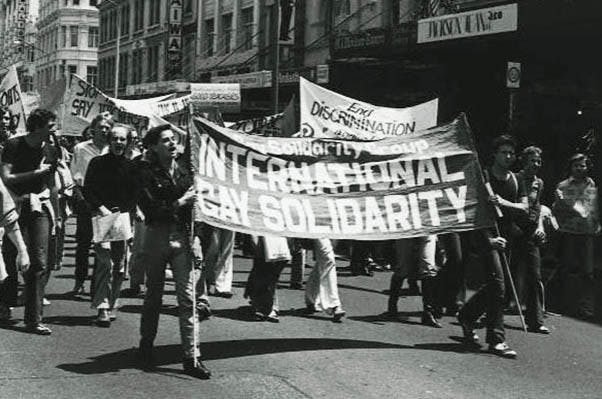When workers went on strike for gay rights

Fifty years ago, the world witnessed the first strike for gay rights in one of the more unlikely places: among the leafy suburbs of northern Sydney at Macquarie University.
Macquarie does not have the same reputation for being a hotbed of radicalism as some other universities. But it was there in 1973 that the Builders Labourers Federation instituted the first “pink ban” to defend a student, Jeremy Fisher, who was kicked out of his residential college for being gay.
The gay liberation movement was just taking off in Australia at the time, after years of heavily moralistic and moderate campaigns that appealed for tolerance and acceptance of gay men and lesbians. Gay liberation was a new, radical, chapter in the fight for LGBTI rights, inspired by the 1969 Stonewall riot in the United States.
Fisher was treasurer of the Macquarie Gay Liberation Club and lived in Robert Menzies College. On the night of 26 May 1973, he attempted suicide. While he was recovering in hospital, a psychiatric registrar interrogated him after the university found gay liberation badges and pamphlets in his room.
Immediately following his release from hospital, the head of the college, Anglican priest Dr Alan Cole confronted Fisher about his sexuality and role in the Gay Liberation Club. Fisher confirmed he was gay, and in return, Cole told Fisher to repress his feelings, to seek help and that he was also kicked out of the college.
Distraught and angry, Fisher went to the Macquarie University Student Council. Specifically, he spoke to Jeff Hayler and Rod Webb, two members of the Socialist Youth Alliance, the leading left-wing group at Macquarie. “I explained my problem with Robert Menzies College and they immediately went to work, ringing their contacts across Sydney”, recounted Fisher, writing in Overland in 2008.
The fight was on. The council called a snap demonstration demanding the disaffiliation of the college from the university if it refused to readmit Fisher. Importantly however, Hayler and Webb knew that if the campaign was to succeed, they needed to get workers on side. And who better to approach than members of the militant BLF, who were building additions to Robert Menzies College and other university buildings at the time.
The BLF was one of the most radical unions during the 1970s, headed in NSW by Communist Jack Mundey. Under Mundey’s leadership, the BLF had dramatically changed the face of workers’ struggle, not only fighting for pay rises and better working conditions, but also popularising the use of “green bans” to save important green spaces, working-class community areas and public housing.
When the students first contacted the union, BLF officials were hesitant about taking the issue of gay rights to their members. It was unclear if the labourers would accept the idea of going on strike against homophobia. However, a meeting in late June voted unanimously to down tools and walk off the job at the college. “To our surprise, the men on the job had no hesitation in deciding to go out on strike”, Mundey later said.
For at least a month, BLF members working on the college were on strike. The union eventually extended the pink ban across all construction on campus when it became clear that university management refused to budge on Fisher’s reinstatement.
Fisher was not interested in returning to live at Robert Menzies College. When confronted by this in one meeting with Fisher, union official Bob Pringle was initially confused as to why his members were on strike. But as Fisher recalled, Pringle, without much hesitation, then simply said: “It’s the principle of the thing. They shouldn’t pick on a bloke because of his sexuality”.
Eventually, the Builders Labourers and students were able to force the college to readmit Fisher, a big success for the campaign. What makes this win even more impressive is that it happened five years before the high point of the gay liberation movement, the first Sydney Gay and Lesbian Mardi Gras in 1978.
The success of the world’s first strike for gay rights cannot be understood without noting the politics of the groups involved. On the student side, the Socialist Youth Alliance was a revolutionary Trotskyist organisation that understood that while students could protest and occupy buildings, it was the working class that had real power in society. Hayler and Webb knew that if they could convince workers to go on strike and seriously inconvenience the bosses, this would be far more effective than student activism alone.
On the workers’ side, the politics of the BLF was heavily influenced by the Communist Party of Australia. Mundey and Pringle, among other officials and rank-and-file workers, were members of the CPA, which took a militant approach to union organising. Not only this; they understood the importance of unions taking up “non-industrial” issues to combat oppression, which undermined working-class unity.
This example of working-class radicalism cuts against the myth that male blue-collar workers are naturally socially conservative. They saw a student being attacked for his sexuality and could not let it rest, even if none of them were gay themselves or even knew anyone who was gay.
The BLF members also knew that the same people who were discriminating against Fisher were the workers’ own enemies: the bosses of the university and college. So it was only common sense that they took up the pink ban.